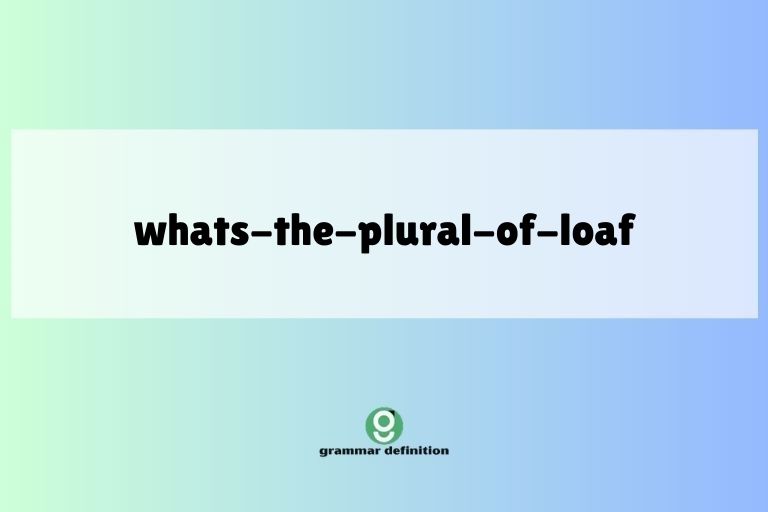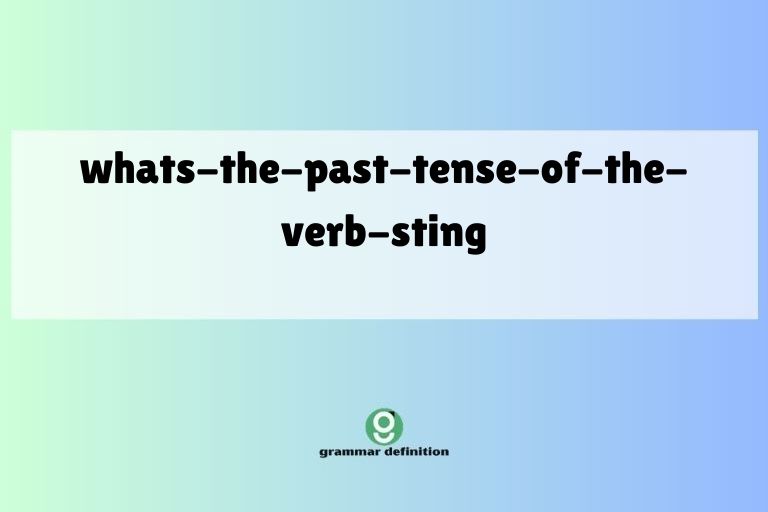What’s the Plural of Loaf? Mastering Irregular Noun Forms

Understanding how to form plurals is a fundamental aspect of English grammar. While many nouns simply add an “-s” to become plural, others, like “loaf,” follow different rules.
Mastering these irregular forms is crucial for clear and accurate communication. This article provides a comprehensive guide to the plural of “loaf,” exploring its definition, usage, and common pitfalls.
Whether you’re an ESL student, a writer, or simply someone looking to improve your grammar skills, this guide will equip you with the knowledge you need to confidently use “loaf” and its plural form, “loaves.”
This article will benefit English language learners, writers, editors, and anyone interested in improving their understanding of English grammar and vocabulary. By the end of this guide, you’ll be able to confidently use the correct plural form of ‘loaf’ and understand the broader rules governing irregular noun plurals in English.
Table of Contents
- Introduction
- Definition of Loaf
- Structural Breakdown: Singular vs. Plural
- Irregular Noun Plurals
- Examples of Loaf and Loaves
- Usage Rules for Loaf and Loaves
- Common Mistakes with Loaf and Loaves
- Practice Exercises
- Advanced Topics: Related Words and Idioms
- Frequently Asked Questions (FAQ)
- Conclusion
Definition of Loaf
A loaf (singular) is a unit of baked food, typically bread, that is shaped and baked in a single piece. It can also refer to a quantity of other foods prepared in a similar form, such as meatloaf or nut loaf. The term generally implies a solid, cohesive mass that can be sliced into individual portions. The etymology of “loaf” traces back to Old English, reflecting its long history as a staple food in many cultures. Understanding the basic definition is essential before delving into its plural form.
Beyond the culinary definition, “loaf” can also be used informally to describe someone who is lazy or spends their time idly. However, this article primarily focuses on the noun’s culinary meaning and its grammatical properties.
The term ‘loaf’ is a common noun, meaning it refers to a general category rather than a specific item.
Structural Breakdown: Singular vs. Plural
The word “loaf” follows an irregular pattern for pluralization. Most nouns in English form their plural by simply adding an “-s” or “-es” to the end of the word.
However, “loaf” changes its ending from “-f” to “-ves” to become “loaves” in the plural form. This pattern is common among nouns ending in “-f” or “-fe,” but it’s not universally applied, making it essential to learn these exceptions.
The transformation from singular to plural involves a phonological shift as well. The “-f” sound in “loaf” becomes a “-vz” sound in “loaves.” This change affects pronunciation and spelling, highlighting the interconnectedness of these two aspects of language.
Recognizing this pattern can help learners identify and correctly use other nouns with similar pluralization rules.
Singular Form: Loaf
The singular form, “loaf,” refers to one single unit of baked bread or a similar food item. Its primary function is to denote a single, countable entity.
It is used in sentences where only one such item is being discussed or referenced.
Plural Form: Loaves
The plural form, “loaves,” refers to two or more units of baked bread or similar food items. It indicates a quantity greater than one.
The shift from ‘f’ to ‘ves’ is a characteristic of irregular plural formation in English. It is used in sentences where multiple such items are being discussed or referenced.
Irregular Noun Plurals
English grammar features many irregular nouns that don’t follow the standard pluralization rules. These exceptions often stem from historical linguistic changes and can be challenging for learners.
Nouns ending in “-f” or “-fe” often, but not always, change to “-ves” in the plural. Other common irregular patterns include changes in the vowel sound (e.g., “foot” to “feet”) or the addition of “-en” (e.g., “ox” to “oxen”).
Understanding these irregular patterns requires memorization and practice. Recognizing common patterns can help, but it’s also important to be aware of exceptions and to consult a dictionary when in doubt.
Mastering irregular plurals is essential for accurate and fluent communication in English.
Common “-f” to “-ves” Plurals
Many nouns ending in “-f” or “-fe” follow the same pattern as “loaf,” changing to “-ves” in the plural. Here are some common examples:
- Wife – Wives
- Life – Lives
- Knife – Knives
- Wolf – Wolves
- Shelf – Shelves
- Thief – Thieves
Exceptions to the “-f” to “-ves” Rule
It’s important to note that not all nouns ending in “-f” or “-fe” follow this rule. Some simply add “-s” to form the plural.
Here are some common exceptions:
- Chief – Chiefs
- Roof – Roofs
- Cliff – Cliffs
- Proof – Proofs
- Safe – Safes
Examples of Loaf and Loaves
To solidify your understanding, let’s look at various examples of “loaf” and “loaves” used in sentences. These examples are categorized to illustrate different contexts and usages.
Examples Using “Loaf” (Singular)
The following table provides examples of the singular form of the word ‘loaf’ used in a variety of sentences. These examples demonstrate the usage of ‘loaf’ when referring to a single unit of bread or a similar baked food.
| Sentence |
|---|
| I bought a loaf of bread at the bakery. |
| She baked a loaf of banana bread for the potluck. |
| He ate a whole loaf of bread in one sitting. |
| Could you slice me a piece from that loaf? |
| The recipe calls for one loaf of sourdough. |
| I prefer a loaf of whole wheat bread. |
| She wrapped the loaf in a clean cloth. |
| The aroma of freshly baked loaf filled the kitchen. |
| He carefully cut a thick slice from the loaf. |
| I need a loaf of bread to make sandwiches. |
| This loaf is still warm from the oven. |
| The baker displayed a beautiful loaf of rye bread. |
| He offered me a slice of the loaf. |
| The loaf was perfectly golden brown. |
| She put the loaf on the cooling rack. |
| He unwrapped the loaf and took a bite. |
| I can smell the fresh loaf from here. |
| She made a delicious meat loaf for dinner. |
| He carved a piece from the meat loaf. |
| The meat loaf was seasoned perfectly. |
| She served the meat loaf with mashed potatoes. |
| The vegetarian option was a nut loaf. |
| He sampled the nut loaf with interest. |
| The nut loaf was surprisingly tasty. |
| She added herbs to the nut loaf. |
Examples Using “Loaves” (Plural)
The following table provides examples of the plural form of the word ‘loaves’ used in a variety of sentences. These examples demonstrate the usage of ‘loaves’ when referring to multiple units of bread or similar baked foods.
| Sentence |
|---|
| I bought three loaves of bread for the week. |
| She baked several loaves of bread for the bake sale. |
| The bakery sells dozens of loaves every day. |
| We need to buy loaves of bread for the party. |
| He carried two loaves of bread home from the store. |
| The homeless shelter received many loaves of bread. |
| The shelves were filled with loaves of different types of bread. |
| She stacked the loaves neatly on the counter. |
| He distributed the loaves among the villagers. |
| I prefer to buy several loaves at once. |
| These loaves are still warm from the oven. |
| The baker displayed a variety of loaves. |
| He offered us several loaves to choose from. |
| The loaves were all perfectly baked. |
| She wrapped the loaves individually. |
| He loaded the loaves into the van. |
| I can smell the fresh loaves baking. |
| She made several meat loaves for the freezer. |
| He prepared three meat loaves for the family reunion. |
| The meat loaves were seasoned with various spices. |
| She served the meat loaves with a side of gravy. |
| The vegetarian option included several nut loaves. |
| He sampled the nut loaves with enthusiasm. |
| The nut loaves were made with different nuts and seeds. |
| She arranged the nut loaves on a platter. |
Comparative Examples: Singular vs. Plural
The following table directly compares sentences using both the singular (“loaf”) and plural (“loaves”) forms, highlighting the difference in meaning and usage. This side-by-side comparison should help clarify the correct application of each form.
| Singular (Loaf) | Plural (Loaves) |
|---|---|
| I need to buy a loaf of bread. | I need to buy several loaves of bread. |
| She baked a loaf for the party. | She baked multiple loaves for the party. |
| He ate half a loaf for lunch. | He ate two whole loaves in one day. |
| The recipe requires one loaf of sourdough. | The recipe requires three loaves of sourdough. |
| I prefer a loaf of whole wheat. | I prefer several loaves of whole wheat. |
| She wrapped the loaf carefully. | She wrapped the loaves individually. |
| The aroma of the loaf filled the room. | The aroma of the loaves filled the kitchen. |
| He cut a slice from the loaf. | He cut slices from the loaves. |
| This loaf is fresh. | These loaves are fresh. |
| The baker displayed a loaf of rye. | The baker displayed several loaves of rye. |
| He offered me a slice of the loaf. | He offered me slices from the loaves. |
| The loaf was golden brown. | The loaves were golden brown. |
| She put the loaf on the table. | She put the loaves on the table. |
| He unwrapped the loaf. | He unwrapped the loaves. |
| I can smell the loaf baking. | I can smell the loaves baking. |
| She made a meat loaf. | She made several meat loaves. |
| He carved a piece from the meat loaf. | He carved pieces from the meat loaves. |
| The meat loaf was delicious. | The meat loaves were delicious. |
| She served the meat loaf. | She served the meat loaves. |
| The vegetarian option was a nut loaf. | The vegetarian options were nut loaves. |
| He sampled the nut loaf. | He sampled the nut loaves. |
| The nut loaf was tasty. | The nut loaves were tasty. |
| She added herbs to the nut loaf. | She added herbs to the nut loaves. |
Usage Rules for Loaf and Loaves
The correct usage of “loaf” and “loaves” depends on whether you are referring to a single unit or multiple units. Use “loaf” when referring to one item and “loaves” when referring to two or more items.
This rule applies to both literal references to bread and metaphorical or extended uses of the word, such as in cooking (meatloaf) or informal contexts.
Pay attention to the context of the sentence to determine whether the singular or plural form is appropriate. Incorrect usage can lead to confusion and miscommunication.
Always double-check your writing to ensure that you’ve used the correct form of the word.
Loaf as a Countable Noun
“Loaf” is a countable noun, meaning it can be counted and has a plural form. This contrasts with uncountable nouns (like “water” or “sand”), which cannot be counted and do not typically have a plural form (although they can be used with units of measure).
Because “loaf” is countable, it follows the rules for pluralization, even though its plural form is irregular.
Articles and Quantifiers
The choice of article or quantifier also depends on whether you’re using the singular or plural form. Use “a” or “an” with the singular form (“a loaf”) and quantifiers like “some,” “many,” “several,” or numerical adjectives (e.g., “two,” “three”) with the plural form (“some loaves,” “three loaves”).
The use of correct articles and quantifiers enhances the clarity and grammatical accuracy of your sentences.
Common Mistakes with Loaf and Loaves
One of the most common mistakes is using “loafs” as the plural form. This is incorrect; the correct plural form is “loaves.” Another common error is using “loaf” when referring to multiple items.
Being aware of these common mistakes can help you avoid them in your own writing and speaking.
Another potential error is misapplying the “-f” to “-ves” rule to other nouns that don’t follow it. Remember that not all nouns ending in “-f” or “-fe” change to “-ves” in the plural.
Careful attention to spelling and grammar rules is essential for avoiding these mistakes.
Correct vs. Incorrect Examples
The following table provides examples of correct and incorrect usage of “loaf” and “loaves,” highlighting common mistakes and their corrections.
| Incorrect | Correct |
|---|---|
| I bought two loafs of bread. | I bought two loaves of bread. |
| She baked a loaves of banana bread. | She baked a loaf of banana bread. |
| He ate a whole loafs. | He ate a whole loaf. |
| We need to buy a loaves. | We need to buy a loaf. |
| There are many loaf on the shelf. | There are many loaves on the shelf. |
| I only need one loaves. | I only need one loaf. |
| She made several meat loafs. | She made several meat loaves. |
| He prefers a whole wheat loafs. | He prefers a whole wheat loaf. |
| The recipe calls for two loaf. | The recipe calls for two loaves. |
| These loafs are fresh. | These loaves are fresh. |
Practice Exercises
Test your understanding with these practice exercises. Fill in the blanks with the correct form of “loaf” or “loaves.” Check your answers at the end of the section.
Exercise 1: Fill in the Blanks
Complete the sentences below by filling in the blanks with either “loaf” or “loaves.”
- I need to buy a _______ of bread for sandwiches.
- She baked three _______ for the bake sale.
- He ate half a _______ of bread with his soup.
- The recipe calls for two _______ of sourdough.
- I prefer a _______ of whole wheat bread.
- She wrapped the _______ in a clean cloth.
- The aroma of freshly baked _______ filled the kitchen.
- He carefully cut a slice from the _______.
- These _______ are still warm from the oven.
- The baker displayed several _______ of rye bread.
Answer Key:
- loaf
- loaves
- loaf
- loaves
- loaf
- loaf
- loaf
- loaf
- loaves
- loaves
Exercise 2: Correct the Sentences
Identify and correct the errors in the following sentences. Rewrite the sentences with the correct form of “loaf” or “loaves.”
- I bought two loafs of bread.
- She baked a loaves of banana bread.
- He ate a whole loafs.
- We need to buy a loaves for the party.
- There are many loaf on the shelf.
- I only need one loaves.
- She made several meat loafs for the freezer.
- He prefers a whole wheat loafs.
- The recipe calls for two loaf.
- These loafs are fresh.
Answer Key:
- I bought two loaves of bread.
- She baked a loaf of banana bread.
- He ate a whole loaf.
- We need to buy a loaf for the party.
- There are many loaves on the shelf.
- I only need one loaf.
- She made several meat loaves for the freezer.
- He prefers a whole wheat loaf.
- The recipe calls for two loaves.
- These loaves are fresh.
Exercise 3: Sentence Completion
Complete each sentence using either “loaf” or “loaves” in a way that makes logical sense.
- For the picnic, we packed a _______ of sourdough bread.
- The bakery had a special on _______ of rye bread.
- Could you please pass me a slice from that _______?
- She donated several _______ of bread to the food bank.
- The smell of freshly baked _______ wafted through the air.
- He spread butter on each slice from the _______.
- We need to buy more _______ if we want to make sandwiches for everyone.
- The baker carefully arranged the _______ on the display shelf.
- She decided to bake a _______ of banana bread as a gift.
- The homeless shelter gratefully accepted the donation of several _______.
Answer Key:
- loaf
- loaves
- loaf
- loaves
- loaf
- loaf
- loaves
- loaves
- loaf
- loaves
Advanced Topics: Related Words and Idioms
Beyond the basic usage of “loaf” and “loaves,” there are related words and idioms that add depth to your understanding of the term. Exploring these advanced topics can enhance your vocabulary and improve your overall language proficiency.
Related Words
Words related to “loaf” include “bread,” “bun,” “roll,” and “pastry.” These words all refer to baked goods, but they differ in shape, size, and ingredients. Understanding these nuances can help you choose the most appropriate word for a given context.
Idioms with “Loaf”
The idiom “to take the bread out of someone’s mouth” means to deprive someone of their livelihood or basic needs. This idiom highlights the importance of bread as a staple food and a symbol of sustenance.
Another idiom is “half a loaf is better than none,” which means that it’s better to have something than nothing at all. These idioms add color and expressiveness to the English language.
Frequently Asked Questions (FAQ)
Here are some frequently asked questions about the plural of “loaf” and related topics.
- Q: Why is the plural of “loaf” “loaves” and not “loafs”?
A: The plural of “loaf” is “loaves” due to a historical linguistic pattern in English where nouns ending in “-f” or “-fe” often change to “-ves” in the plural. This is an irregular pluralization rule that doesn’t apply to all nouns, but it’s the established form for “loaf.”
- Q: Are there any other words that follow the same pluralization rule as “loaf”?
A: Yes, several other words follow the same rule, including “wife” (wives), “life” (lives), “knife” (knives), “wolf” (wolves), “shelf” (shelves), and “thief” (thieves).”
- Q: What if I accidentally use “loafs” instead of “loaves”?
A: While understandable, especially for non-native speakers, using “loafs” is considered grammatically incorrect. Most people will likely understand your meaning, but it’s best to use the correct form, “loaves,” for clear and accurate communication.
- Q: Is “loaf” always used to refer to bread?
A: No, “loaf” can also refer to other foods prepared in a similar shape, such as meatloaf or nut loaf. The term generally implies a solid, cohesive mass that can be sliced into individual portions.
- Q: Can “loaf” be used as a verb?
A: Yes, “loaf” can also be used as a verb, meaning to spend time idly or lazily. However, this article primarily focuses on the noun form and its pluralization.
- Q: How can I remember the correct plural form of “loaf”?
A: One way to remember is to associate “loaf” with other similar words that follow the “-f” to “-ves” rule, such as “knife” and “life.” Practice using the word in sentences to reinforce the correct form.
- Q: Are there any regional variations in the usage of “loaf” and “loaves”?
A: No, the usage of “loaf” and “loaves” is generally consistent across different English-speaking regions. The pluralization rule is standard and widely accepted.
- Q: Is it ever acceptable to use “loaf” as an uncountable noun?
A: No, “loaf” is always a countable noun. If you want to refer to an indefinite amount of bread, you would typically use phrases like “some bread” or “a lot of bread” rather than trying to treat “loaf” as uncountable.
Conclusion
Mastering the plural of “loaf” is a crucial step in improving your English grammar skills. Understanding the irregular pluralization rules and common exceptions will enable you to communicate more effectively and accurately.
Remember that “loaf” becomes “loaves” in the plural, and that this pattern is shared by other nouns ending in “-f” or “-fe,” though not universally.
By studying the definitions, examples, and practice exercises provided in this guide, you can confidently use “loaf” and “loaves” in your writing and speaking. Pay attention to the context of each sentence and double-check your work to avoid common mistakes.
Continued practice and exposure to the English language will further solidify your understanding and fluency. Accurate grammar enhances clarity and credibility in all forms of communication, making the effort to master these rules well worth it.






